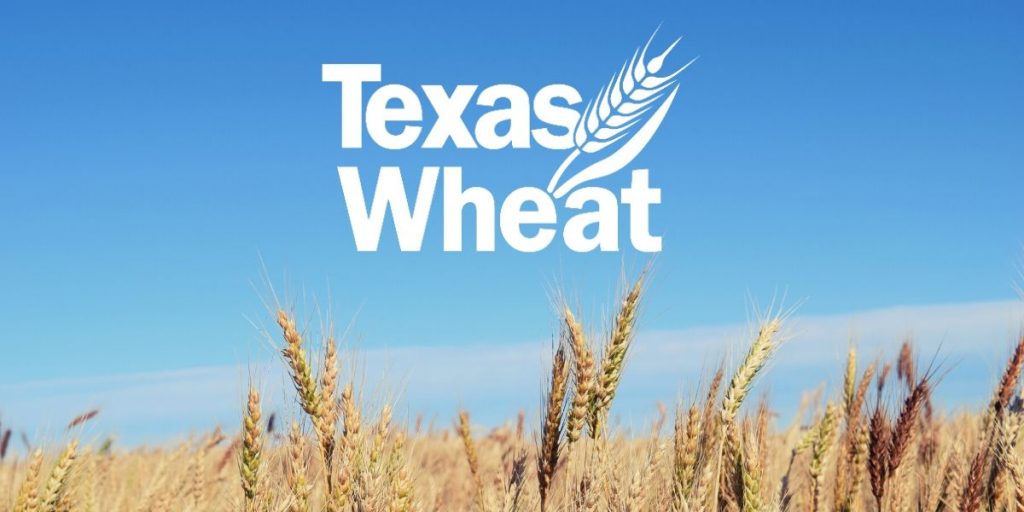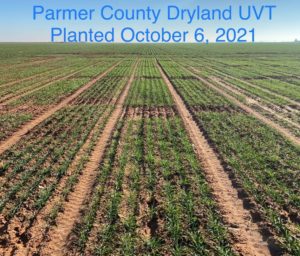By: Dr. Calvin Trostle, Extension Agronomy, TAMU Dept. of Soil & Crop Sciences, Lubbock, (806) 746-6101, ctrostle@ag.tamu.edu
Wheat Conditions in Texas
As you too well know conditions across most of Texas have gradually turned dry and worse into extreme drought (Fig. 1). For the northwest half of Texas winter is not the time we regularly get much moisture. Historically if wheat is established it can be pretty tough and can usually hang on until spring moisture comes, hopefully in time to take advantage of the burst of forage growth after jointing or for grain.

For much of northwest Texas dryland wheat establishment is the issue. There appears to be a substantial difference due to planting date. Dr. Jourdan Bell (jourdan.bell@ag.tamu.edu), AgriLife Extension Agronomist, Amarillo, notes 2021 planting date had a significant impact on much High Plains wheat. If soil moisture was still available at earlier planting dates (September for grazing, by early October for grain) then the all-important stand establishment was achieved (Fig. 2). Some stands look surprisingly good. This is the best situation you could hope for in our current weather—stand establishment. At least the potential is still in the crop pending further moisture.
Scott Strawn (scott.strawn@ag.tamu.edu), Ochiltree Ag. Extension agent, notes ~85% of dryland wheat there has emerged. Most is very limited in growth and has not tillered much. Surprisingly it is still alive despite the extreme dry conditions. Scott further notes, however, “Wheat has made a liar out of me way too many times during this time of year, so I am not going to count it out yet. February 15 through March 30 will be the critical time frame here to see where this will go. If this dryness persists through that time frame, a total crop failure will occur. Even with excellent moisture yields could already be reduced due to little early tillering.”
Later-planted wheat has struggled with establishment (Fig. 3). One issue with late planted wheat is recent light showers wet the soil about 2-3” deep. This has potentially provided enough moisture to germinate seed and possibly emerge or help poorly established wheat hang on. However, there is a zone of dry soil underneath this seed (Fig. 4). Roots will not penetrate dry soil. In effect wheat is trapped above this dry zone with moisture only available in the top 2 or 3”. This moisture is not enough to sustain the wheat for long. It is worsened by warm days and winds. Without sufficient moisture to bridge the soil dry zone, wheat potential is very low. Earlier planted wheat where moisture was available did not have this dry zone. It has rooted deeper and can hang on for two months or more.

Grazing on dryland wheat in the Rolling Plains, South Plains, and Panhandle has been very limited to none without irrigation. Some Central Texas wheat is also beginning to lose grazing potential.
A report from Tyler Mays (tyler.mays@ag.tamu.edu), AgriLife IPM Extension agent, Hill Co. (Central Texas) notes all wheat is well established. But some is starting to suffer from minimal moisture. A telling sign is the common shrink-swell soils (Vertisols, like Houston Black clay) are cracking many inches deep. This wheat, like the northwest part of the state, is in significant moisture stress, much induced not merely by lack of rainfall, but higher temperatures in the 70s and even 80s°F. But this region of the state is farm more likely to receive winter precipitation. The average historical rainfall in all individual winter months at Waco is greater than the four-month Nov.-Feb. average precipitation at Lubbock.


Dilemma: Top-Dressing Wheat and High Fertilizer N Prices
Nitrogen prices are in many cases more than double vs. one year ago. Spot price checks across Texas for popular N fertilizers for top dressing wheat are $910-950/ton for urea (46-0-0) and $645-695/ton for liquid urea-ammonium nitrate (UAN, 32-0-0). Hence the cost of a unit of nitrogen (1.0 lb. of actual N) is $1.00 to $1.09 (100 lbs. of urea would be 46 lbs. of actual nitrogen). Variables in N fertilizer prices mostly reflect transportation. Fertilizer prices closer to Borger and Beaumont, TX for example, are lower due to N fertilizer manufacturing facilities.
Farmers face decisions on what if any top-dress N to consider for Texas wheat. The following factors will influence spring top-dress N decisions:
• Late-spring wheat condition including soil moisture
• Price of nitrogen fertilizer
• Wheat price prospects
• In-season winter soil testing wheat fields for soil N status
Late spring wheat conditions and soil moisture
As described above much of the Texas wheat crop is facing poor conditions due to drought. Warmer than normal temperatures have compounded this issue by forcing premature use of scarce soil moisture now when it is less likely to contribute to yield vs. delayed moisture consumption to drive reproductive growth starting at jointing.
Some farmers may have applied N already ahead of seeding. Others may have declined to do so due to already existing dry conditions. If you have a wheat crop that appears to be worth fertilizing, then consider the additional topics.
Price of nitrogen fertilizer
As noted above N prices are at record highs. At current prices farmers may decide not to topdress any N. Remember, though, “you can’t get something from nothing” for very long if your wheat crop does have potential but has little nitrogen to drive growth. Second only to available moisture, nitrogen is likely the next most important yield-yield limiting factor in Texas wheat.
Will N fertilizer prices decline by the time I need to topdress N? Fertilizer supply will affect prices, too. If supplies are sketchy in late winter, then do not expect substantial changes in N fertilizer prices. At this time, it would not appear prices could change much for wheat farmers in central Texas and further south consider topdressing. These N applications are needed by jointing, and that could be occurring in a little over a month in those regions.
Dr. Mark Welch (mark.welch@ag.tamu.edu), Professor & AgriLife Extension economist, College Station, commented on fertilizer and commodity prices on 12/15/2021: “The price move we see in nitrogen is driven by higher natural gas prices and higher grain prices. But the degree of price increase in fertilizer is out of proportion to the prices of natural gas and grain. No surprise that fertilizer is higher, but not this high. Both the price of natural gas and grain are likely to be lower in 2022. I do not see record high N prices continuing long term. But that does not mean they will drop much by late winter/spring when we need to get fertilizer applied for first wheat then summer crops. Growers in north Texas and especially the High Plains will have more time before making a final decision on N.”
“For different crops, even with these higher input prices, the returns above variable costs in my 2022 budgets appear better than they were last year looking ahead to 2021. Our output commodity prices are still high enough to make these higher fertilizer input prices manageable. The risk of course is we get all these high-priced inputs locked in and then see output (crop) prices fall by harvest.”
Regardless your production objective remember the first units of N you apply to a field or a crop are the most valuable. The first 33% of N you apply is more valuable and will give a better return than the last 33%. Even though fertilizer N prices are high, at least some N likely still offers a more certain net return than larger amounts. Reducing N applications may be the right decision, but eliminating all N is not.
Wheat price prospects
The Kansas City Board of Trade is the common futures market that indicates trends and levels in the wheat market for Texas. For the week of Jan. 3, 2022, futures for July 2022 are about $8/bushel. This is high. The board futures, however, are not what the cash market could be at Texas wheat harvest time. With prices like this, a simple yardstick to apply is “At these high prices for wheat (or other crops) are prices likely to increase further or decrease?” Barring any significant market news like droughts in other wheat-producing countries or higher than expected demand or export sales, wheat prices probably are more likely to decline. So, should you lock in wheat prices? If you are irrigated or in a Texas region where rainfall is expected, then consider doing so. Otherwise, with the drought across much of Texas this is too risky and of no consideration for wheat in dryland settings.
In-season winter soil testing for wheat—Action item!
We typically view soil testing as an off-season task. Soil sampling for wheat most likely occurs in August to possibly October depending on your Texas location. The impetus for soil testing is greater when fertilizer—and crop commodity—prices are high. On one hand you do not want to spend unnecessarily for fertilizer. On the other hand, you want to ensure potential for higher yields to take advantage of higher wheat prices and increase profitability.
Traditional soil testing is only a six-inch sample. This is changing. Major agriculture states like Kansas and North Dakota now recommend 24” sampling (as one depth) for all nutrients. The potential presence of nitrate-nitrogen (NO3-) is the driver for deeper soil sampling. In any Texas soil, for any Texas crop, Texas A&M AgriLife research suggests nitrate-N down to 24” is fully available to your crop. Credit all this N toward your fertilizer requirement. It is not uncommon for farmers to find 30 to 60 lbs. of N per acre in the top 24”, often double or more what is expected. This represents a potential fertilizer N savings of at least $15 to $30 per acre.
Even if you applied some pre-plant fall N to your wheat, consider soil testing now to determine what is available. I recommend for 2022 Texas winter wheat sampling now at least 18” deep and preferably 24”. Sampling only 6” now is of little value for an existing wheat crop.
Texas A&M AgriLife’s Soil Testing Lab, College Station, for years has offered a “Profile Soil Sample Information Form” specifically for deep soil sampling for nitrate-N only (currently $6/sample). This form has not been renewed for 2022. Instead, you can use the standard form at http://soiltesting.tamu.edu/files/soilwebform.pdf. In the instructions 1) note the full depth of the soil sample, e.g., 0-18”, 0-24”, etc., and 2) that you want nitrate only (or you can do the ‘Routine Analysis’ for $12). Many crop consultants offering soil sampling services routinely use sampling deeper than 6” often to include nitrate-N assessment 18” or 24” deep. This is a strongly recommended practice.
Additional AgriLife Resources for Wheat Top-Dress Decisions
In past updates, AgriLife Extension has discussed wheat topdress N decisions for amount and timing and other factors. You may review “Nitrogen and Texas Wheat Grain Production—Topdress N Timing is Critical” (Twelve Common Questions) at http://varietytesting.tamu.edu/files/wheat/docs/fertility/TopDress-N-Wheat-2019.pdf


